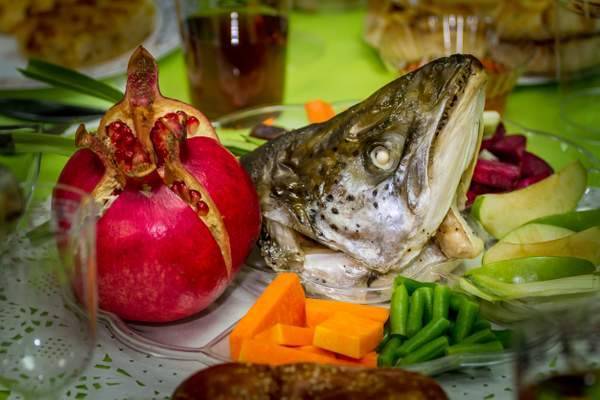The festival consists of many elements, including prayer services in synagogue and the blowing of an ancient musical horn called a shofar, which is made from a ram’s horn.
However, one of the most anticipated aspects of Rosh Hashanah is undeniably all of the delicious, sweet foods that Jews eat throughout the festival, which starts this year on the evening of September 9 and ends on Tuesday September 11.
During Rosh Hashanah, Jews will frequently say the Hebrew phrases “Shana Tova” or “Shana Tova U’Metukah” to one another, meaning “A good year” or “A good and sweet year.”
The sweet foods that Jews eat during Rosh Hashanah are therefore meant to symbolise the hope for a sweet and happy year ahead.
One of the most recognisable food staples that adorns the dinner table during Rosh Hashanah is apple and honey, a traditional combination that has passed down the generations for centuries.
This is accompanied by a song that’s taught to young children at cheder (Jewish Sunday school), which goes: “Dip the apple in the honey, make a bracha [blessing] loud and clear. L’Shana Tova U’Metuka, have a happy sweet New Year.”
In addition to dipping the apple in the honey, Jews also frequently eat honey cake, pomegranates and round raisin loaves of challah to see in the New Year.
Read all about the foods that are traditionally served during Rosh Hashanah, from honey cake to a fish’s head:
Apple and honey

Apple and honey (Getty Images/iStockphoto)
The dipping of the apple in the honey is one of the most recognisable traditions associated with Rosh Hashanah.
The honey symbolises the excitement for a sweet New Year ahead.
It’s believed that centuries ago, the apple was chosen as the fruit that was to be dipped into the honey on Rosh Hashanah due to the symbolic nature of the fruit.
According to a Lexicon of Jewish Cooking, written by Patti Shosteck, in medieval times apples were so revered that people would carve prayers into the apple skins before eating them.
Pomegranate

Pomegranate (Getty Images)
The pomegranate is also a highly symbolic fruit eaten by the Jews during the New Year.
The Torah, the Jewish scroll that contains the first five books of the Tanakh, consists of 613 “mitzvot”, or commandments.
The Jewish Museum in New York City states that a pomegranate supposedly consists of 613 seeds, which is why it’s eaten during Rosh Hashanah.
On top of that, it’s also a sweet fruit, which is why it ties in nicely with the festival.
Jews also eat many other types of fruits during Rosh Hashanah, including dates, lychees and star fruits.
Round raisin challah

Round challah (Getty Images/iStockphoto)
Challah is a special Jewish bread that’s frequently eaten on Shabbat and during religious festivals.
Usually challah loaves are plaited and adorned with different types of seeds, such as sesame or poppy seeds.
However, when Rosh Hashanah comes around, round raisin challahs become especially popular as opposed to long, plaited variations.
Project Genesis, a Jewish education organisation, recommends substituting the raisins for dried cranberries or sour cherries as an alternative to the raisin loaf.
Kiddush wine

Kiddush wine (Getty Images/iStockphoto)
A Jewish celebration isn’t complete without an abundance of kiddush wine to mark the occasion.
A “kiddush” is a type of blessing recited over wine or grape juice during Shabbat or other Jewish festivals.
Kiddush wine is typically much sweeter than other types of wine.
It’s explained on the Chabad website that during periods of time when Jewish communities were impoverished, many couldn’t afford to buy expensive wine for Shabbat.
With this in mind, they would often have to resort to buying cheap, sweet wine that was sometimes made from raisins instead.
Honey cake

Honey cake (Getty Images/iStockphoto)
It should come as no surprise that honey cake is eaten during Rosh Hashanah, what with the festival’s focus on tasty, sweet food.
Many Jewish people who make honey cake to celebrate the New Year will make batches that they’ll then give to friends and family to spread love and happiness during the festive occasion.
The cake’s ingredients often include cinnamon, ginger and, of course, honey or syrup.
Fish head

Fish's head (Getty Images/iStockphoto)
It’s customary for some Jews to eat a fish’s head on Rosh Hashanah.
Why, you may ask? The reasoning stems from the literal translation of the festival’s name.
“Since ‘Rosh Hashanah’ translates literally as ‘Head of the Year,’ eating a fish head on the holiday became a little joke about the verse,” explainedJeremy Kalmanofsky, rabbi of New York City’s Conservative Ansche Chesed.
“You should start your year as the head [or leader] and not the tail [or follower]."
The Independent
More about: holiday
















































